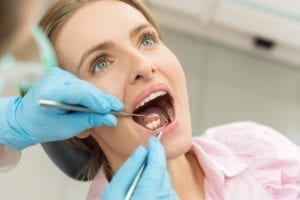An estimated 80% of Americans suffer from some form of periodontal or gum disease. Luckily, gum disease is treatable if caught early. Dr. Gregory Hillyard and Dr. Alexandra Monroe can diagnose and treat gum disease at routine visits to their Media, PA, dental office. They look for the early warning signs of developing gum disease during all routine visits. Gum disease is a restorative dentistry treatment in Media, Pennsylvania.
Periodontitis, or gum disease, has early warning signs. These early symptoms can quickly snowball into serious dental problems. Gingivitis is the first stage of gum disease, characterized by red, swollen, irritated gums. Harmful bacteria irritate the gum tissues. If gingivitis progresses, it can become periodontitis. Eventually, patients with severe gum disease can lose their permanent teeth.

Signs of Gum Disease
The very early stages of gum disease are difficult to notice. This is why our trained dental staff examines every patient for signs of gum disease at your regular dental appointments. As gum disease progresses, you may notice some of the following symptoms:
- Bleeding gums
- Red, swollen, or painful gums
- Bad breath that doesn’t go away
- Pain in the mouth
- Gums that are pulling away from the teeth, or your teeth appear longer than usual
- Teeth that feel loose
- Pus between your gums and teeth
Call our office immediately to schedule an appointment if you notice these symptoms. Early intervention can prevent gum disease from worsening over time.
Stages of Gum Disease
Learn the stages of gum disease and symptoms that occur at each stage:
- Gingivitis: Early signs of gum disease at this stage include irritated and inflamed gum tissue. You can also experience bleeding gums when you brush and floss. Receiving professional dental cleanings can help reverse these early symptoms.
- Mild Periodontitis: As gingivitis becomes gum disease, you can notice chronic gum pain and sensitivity. You may also notice your gums begin to pull away from the teeth.
- Moderate Periodontitis: You experience increased bone loss at this stage as teeth lose support from the soft tissues. Moderate gum disease is also marked by increased pain and discomfort.
- Advanced Periodontitis: This is the final stage of gum disease. Deep gum pockets and loose teeth are common at this stage. Advanced gum disease is irreversible.
Gum Disease Treatment in Media, PA
Our office provides cleanings, scaling, and root planing. Routine dental cleanings may be enough to treat early signs of gum disease. However, scaling and root planings can keep bacteria in check if you have moderate gum disease.
Dental Cleanings
Remember to brush your teeth twice daily with an electric toothbrush, floss daily, and use a water pick. We will work with you to help you understand how to properly care for your teeth and determine the best home care regimen based on your needs.
Our hygienists use the latest technologies in our office to provide you with the most thorough cleaning possible. Our Cavitron is used to debride heavy calculus through sonic vibrations and flushing the area with warm water.
Ultrasonic scaling is ideal, leading to less time in the chair for this procedure. It’s efficient enough to take care of even the most stubborn calculus. Dental anxiety prevents many adults from going to the dentist. Having quicker, more comfortable technology is essential.
The Cavitron is designed to be more comfortable for patients and dental workers. Increasing comfort can also help with dental anxiety and ensure patients are more willing to get treatment. It’s also ideal for the staff to be as comfortable as possible throughout their workday.
Baking soda spray is used for harder-to-reach areas and is particularly good for children in orthodontics brackets. We have multiple flavors of prophy paste to choose from and will give your teeth a thorough polishing once all calculus and plaque have been removed.
Scaling and Root Planing
We offer intensive cleaning to remove plaque buildup in the gum pockets and along tooth roots. Scaling and root planing are some of the best non-surgical treatments for gum disease. To begin a scaling treatment, we use a local anesthetic to numb the area for patient comfort. Then, we clean harmful bacteria in the gum pockets beneath the gum line.
After scaling, we perform a root planing. Root planing smooths out the tooth root. Smoothing the root creates a clean surface for the gums to reattach to the teeth. Then, we place antibiotics in the gum pockets to fight harmful bacteria.
Some patients with chronic gum disease symptoms may return for scaling and root planing multiple times yearly. This deep cleaning can reduce the number of harmful bacteria that irritate the gum tissue.
Gum Disease FAQs
Read answers to common questions about periodontal disease treatment in Media, PA:
Will I need X-rays for periodontal disease treatments?
Yes. X-rays are essential to diagnose periodontal disease. That’s because it allows the dentist to observe the state of the bone and periodontal ligament. This way, the dentist can design the best treatment plan for your case.
Can I get periodontal disease treatment if I’m pregnant?
Yes. Pregnant women should get regular check-ups and gum treatments. There are non-invasive periodontal treatments such as scaling or root planing. It’s even safe to perform surgery after the first pregnancy trimester if the patient needs it.
Will one session of dental cleaning be enough to treat my periodontal disease?
It depends on the case. A dental cleaning might be enough for mild gingivitis with one dental cleaning appointment. However, moderate to severe cases will take two or more sessions.
How can I clean my mouth after periodontal surgery?
Don’t brush or floss the area of the surgery for a week. After that, you can use a soft-bristle toothbrush to brush your teeth gently. Avoid the gum area and clean the rest of your teeth normally.
How long does it take the gums to heal?
The time it takes for the gums to heal after gum disease treatment varies. It can take the gums one week to heal after non-invasive treatments such as scaling and root planing. However, they might take between 2 and 4 weeks to heal after a more invasive treatment such as surgery.
Can I drink alcohol or smoke after getting periodontal disease treatment?
No. You shouldn’t drink alcohol or smoke for at least 72 hours after any periodontal disease treatment, including non-invasive treatments such as root planing. The reason why is alcohol and tobacco can interfere with the healing process of the gums.
How is gum disease linked to heart problems?
If your gums are inflamed or infected, these bacteria can enter your bloodstream through tiny cuts or openings in your gum tissue. Once the bacteria get into your blood, they can cause inflammation (swelling) in other parts of your body, including your blood vessels and heart. This inflammation can contribute to heart disease.
Smoking, a poor diet, and diabetes are also linked to gum disease and heart issues. Keeping yourself healthy can decrease your risk of oral health and overall health problems.
Can a poor diet increase my risk of gum disease?
Yes. Eating too much sugar feeds the harmful bacteria in your mouth. These bacteria produce acid that irritate your gums, causing inflammation and gum disease.
You also need certain vitamins and minerals to stay healthy. Vitamin C helps keep your gums strong, and calcium supports your teeth and jawbone. If your diet is low in these nutrients, your gums may become weaker and more prone to infection.
Not drinking enough water can lead to a dry mouth. Saliva helps wash away food particles and bacteria, and dry mouth increases your risk of gum disease.
Treat Symptoms of Gum Disease
Are you noticing signs of gum disease? Receive professional periodontal disease treatment in Media, PA, today. Call Dr. Hillyard and Dr. Hillyard Monroe at 610.566.0291.

